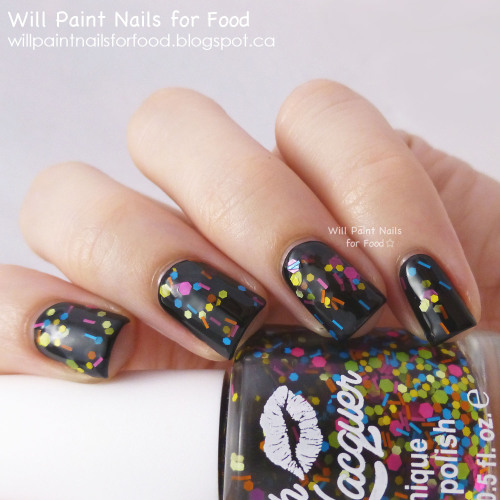#review
New Cremes by Girly Bits Cosmetics
Hi everyone! Indie Brand Girly Bits recently started releasing some creme polishes, and I have the first three up on my blog. These are fantastic in terms of colours and formula so I encourage you to check out my review (link).
Polishes pictured:
- Lover’s Coral
- Mint To Be
- Private Dancer
Follow Will Paint Nails for Food on Facebook and Instagram (@willpaintnailsforfood)
Post link
Me doing a review of the Japanese special edition of the Martin Scorsese film “Silence”.
Unboxing of Jackery Mini Portable Charger 3200mAh - External Battery Pack
I was going over my most liked/reblogged pictures of the year.
Interestingly, my most popular picture this year and of all time was one of a random background character from Star vs the Forces of Evil named Becky wearing a shitty diaper. I was curious as to what made that picture so popular. Is it because she’s crying? Embarrassed? Scantly dressed with tits? Was messy but with no visible indicator of it other than a green stink line protruding from her backside?
The next two most popular after that were both versions of the Paulina diaper picture (jeans over diaper, and full view shit-loaded diaper, standing in the middle of a fast food restaurant). I’ve gotten lots of requests for ABDL Danny Phantom artwork, but I’ve never been too motivated to draw much of it even though I’m a fan of Butch Hartman’s works. I’ll probably revisit it in the future still. Right after those is the older Tootie picture with a massive ass/shitty diaper combo. If Hartman ever does another FOP in 10 years video, the comments in his last one suggest Tootie might be up next, if so you can bet I’ll revisit her, I just hope he does a better job than the lackluster designs he gave Vicky in his last video.
The other top pictures of mostly random characters I’ve done this year: Giffany, Zatanna, a mild Trixie and Veronica age regression picture, Ms. Butterbean, Edna Strickland, some random senorita from Foster’s Home for Watching for Frankie and Nothing Else (and of course Frankie too).
My favorite pictures of this year? Edna Strickland and Giffany required the most effort, the former being I was transforming a 3D game character into a 2D drawing and its probably the closest example you can find of me having my own ‘style’, the latter just had a lot of shading and other things plus I was using a different brush to make it look more ‘pixally’‘. I also loved the stylizing of the Suzy Q picture, and the age regression of Tamako Nobi was a good one as well.
Pictures I wish I could revisit? Well, probably most of them especially those done in the earlier parts of the year, but ones I shit the bed with were the Bulla Briefs picture, which I had actually an earlier version which got corrupted and had to be completely redone, and the Eris picture mainly what’s around her because it looks like she shit out a pile of bones.
Well that’s the yearly review of the blog. I’ll give you all a gift for the holidays: This Trixie Tang picture above is part of a comic sequence I made after Halloween that was so fucking cringey even I was too embarrassed to post it even on diaperedanime, but this particular panel is probably the …. least offensive…
I also have two more pictures I might have done before the holidays. One is of Luan Loud which has been crippled by art block (I’ve had the lineart for this done before I did any of those three Rita Loud pics I’ve posted recently), and an ongoing Gravity Falls picture which will probably be finished soon on simple virtue that I don’t have the skillset to even attempt to recreate Gravity Falls style backgrounds.
Merry Christmas and Happy New Years to all!
Post link
As soon as I finished Voltron S8 I was reading a lot of backlash. Some dislikes I do agree or understand (like some rushed loop holes and Lance & Allura) , but majority of it was foolish high expectations - like how some characters didn’t have that many lines. ♂️ THIS ISN’T A CONTEST. IT WAS THE LAST SEASON. ✌️ The goal of stopping Honerva was accomplished. So the season was solid for me.
➖
Full Vid: https://youtu.be/LdowOIhH4mE
REVIEW: Better Bagels - Vegan Keto Protein Bagels
#CutsCurvesFitness Review - #BetterBrand Vegan Keto Protein Better Bagels


“There’s a train coming!”
The barren, snow-covered landscapes of Jia Zhangke’s Platform evoke the sense of isolation felt by the film’s central characters, a troupe of performers affected by China’s political upheaval in the early 1980’s, and although Zhangke’s elliptical narrative plays a secondary role to his thematic concerns, the performers themselves offer an interesting cross-section of this new China.
They’re heavily influenced by Western culture, with perms, bell bottom jeans and popular music trickling down from the “big cities”, and they share awkward relationships with their lovers (one girl breaks up with her boyfriend by telling him her father doesn’t like him, while he stares at his shoes, swaying from side to side, clearly uncomfortable with the emotional candidness of the situation). In many ways they’re the quintessential youth, which makes Zhangke’s decision to make them the forgotten children of a new regime all the more troubling.
About half way through the film, the performers chase a train as it heads towards a platform. But it doesn’t stop, leaving them stranded in a literal and metaphorical limbo - a middle ground between the China of their parents and the China they one day thought they’d inherit.
It’s a bold artistic statement from Zhangke, and it’s as damning an examination of a society ignoring the margins as you’re ever likely to see. But the turmoil at the heart of Platform is handled with the utmost care and attention that it’s hard not to be swept up in it all.

“Michael?”
Halloween is unquestionably the best time of year to watch horror movies, and what better way to celebrate this most cinematic of holidays than by watching arguably the greatest horror film of all - John Carpenter’s Halloween.
If done right, opening a film with a three minute tracking shot is sure to make a lasting impression on an audience - it worked so well for Orson Welles’ Touch of Evil, after all. John Carpenter’s Halloween opens with such a shot, and while it’s on a smaller scale than that of Welles, it’s every bit as interesting and forewarning. Why? Because it introduces us to Michael Myers, and shows us exactly what he can do.
Following this opening sequence, the film jumps ahead fifteen years, and Myers has escaped from the sanatorium in which he was incarcerated. Armed, dangerous and with a lust for teenage girls, Myers heads back to his hometown.
By modern standards, this looks a clichéd premise, but it’s not the story that makes Halloween so enthralling. Rather, it’s the character of Myers. Having been introduced so startlingly, Myers is immediately a captivating presence on, but mostly off, screen. The camerawork echoes his voyeuristic gaze, lingering on objects for slightly longer than necessary creating a queasily suggestive atmosphere - something is about to happen, it’s just a matter of when.
And happen things do, eventually. Carpenter draws out the tension to such an unbearable length that it’s about half way through before anything really happens. But it’s not the set pieces themselves that lend Halloween its power, but the steady accretion of tension. Faces pop in and out in the shadows, from behind washing lines and in windows, but Myers seems content to just watch his prey. It’s difficult to describe Myers in regular terms. For most of the narrative he’s more ghost than man.
But even then man may not be an entirely accurate description, as Myers has very few human traits. One he does have, however, even if he doesn’t fully understand it, is a lust for women. The majority of his victims are sexualised teenage girls, and he kills them after watching them, like a voyeur, in various states of undress. The only exception to this, aside from the truck driver he kills for his clothes early on, is Laurie, who is prudish in comparison to the others. He doesn’t kill her. Carpenter seems to be treating Myers as an agent of virtue, killing those whose vices rule them. For a film of such violence (some critics say misogyny), Halloween has a surprising moral compass.
But it’s never bogged down by its morals, as, first and foremost, Halloween is a film made to entertain and thrill an audience - something it undoubtedly achieves. The tension Carpenter creates from such mundane activities as three girls walking home from school is spectacular, while the murder scenes are harrowing without being gory.
But, like all good horror films, it’s what you don’t see that resonates the most, and it’s testament to the dazzling brilliance of Halloween that it makes so much out of so little.

“The best of them won’t come for money. They’ll come for me”
David Lean’s grandiose sense of cinematic scale is an asset rarely seen in modern filmmaking, and seeing the towering achievement of Lawrence of Arabia for the first time at the London Film Festival (the new 4K restoration) is only making this fact harder to swallow. So, as this wonderful film turns fifty, now seems the perfect time to reflect on what must be the most extraordinary spectacle the cinema has ever produced, and celebrate the seemingly lost art of “big cinema”.
There aren’t many films as perfectly formed as David Lean’s Lawrence of Arabia. It’s one of a select few - like Citizen Kane, Vertigo, Fitzcarraldo or Apocalypse Now - in which everything seems to align perfectly with a director’s vision, no matter the cost. In the case of this film, the director’s vision is one of extraordinary scale, boldness and ambition. Take the dramatic entrance of Omar Sharif’s Ali, for instance, which sees him appear on the distant horizon as if riding in from the sky. To capture this startlingly beautiful image, cinematographer Freddie Young had to use a 482mm lens designed especially for the shot - a lens that has not been used since.
This is one of a number of hints at Lean’s towering ambition for this bold film. The film was undeniably a large undertaking, but Lean had both the vision and the control to match the scale of the surroundings - surroundings in which he immersed himself, shooting mostly on location in Jordan and Morocco, with southern Spain doubling as desert for some scenes. As a result, the film looks gorgeous. Freddie Young’s spectacular cinematography captures the expansive vistas of Arabia, the chaotic battle sequences and the expression-filled face (and eyes) of Peter O'Toole as Lawrence with such simple majesty.
Of course, it helps when you have a cast as attractive as that of Lawrence of Arabia. The likes of O'Toole, Sharif, Alec Guinness and Anthony Quinn deliver knock-out performances - particularly O'Toole, whose portrayal of T.E. Lawrence was not only his breakthrough role but the finest he has ever been on screen. He makes for a captivating screen presence, bringing the complex character of T.E. Lawrence to life in the most charismatic of ways.
Another breakthrough role was that of composer Maurice Jarre, whose only previous experience had been scoring two films with Georges Franju, Head Against The Wall (1958) and Eyes Without A Face (1959), in his native France. When producer Sam Spiegel approached him to work on Lawrence of Arabia - he was the third choice composer - he had a mere six weeks to score the whole film. The finished result, a powerful score echoing the tumultuous life of T.E. Lawrence as well as the scale of the scenery, won him his first of three Oscars, all of which were for films by David Lean (Doctor Zhivago in 1965 and Ryan’s Daughter in 1970).
Lean’s film was also a launch pad for its editor, Anne V. Coates, whose only experience beforehand was an uncredited second editor role on the Powell and Pressburger film, The Red Shoes (1948), as well as a few assistant roles on small British films. Her virtuosic sense for cuts - particularly the “match cut” sequence, which is surely one of the most impressive jump cuts in film - and pacing won her a deserved Oscar.
All of these individual elements help to make Lawrence of Arabia as great an audio-visual treat as you’re ever likely to see on screen, but it’s in the characterisation of Lawrence that the majority of the film’s criticisms lie. Bosley Crowther of the New York Times wrote of the film: “It is such a laboriously large conveyance of eye-filling outdoor spectacle that the possibly human T. E. Lawrence is lost in it. We know little more about this strange man when it is over than we did when it begins”, while Andrew Sarris of Village Voice labelled Lawrence of Arabia: “coldly impersonal”.
While these criticisms are relatively valid, and it is true that the film does not work particularly well as a detailed character study, this is only because it is not what Lean set out to do. He’s not trying to document the man, he’s trying to capture Lawrence’s spectacular achievements cinematically. This isn’t to say Lawrence is ignored as a character, as O'Toole imbues him with an almost effeminate aura, and a charm as great as his arrogance, but Lean is more interested in the drama than the facts - and who can blame him, he’s not a documentarian, after all.
But as Sarris suggests, one thing Lean’s film is not is a “Kane approach to the mystery of the hero”, but only because it doesn’t try to be. Lawrence of Arabia doesn’t pretend to be anything other than a celebration of Lawrence’s achievements, and the disregard of factual accuracy in the screenplay serves to offer a romanticised depiction of Lawrence and his achievements rather than an accurate retelling of his life.
Ultimately, these complaints are largely confined to a small number of critics and historians. The wider belief (including my own) is that Lawrence of Arabia is a searing indication of David Lean’s talent and ambition as well as an extraordinarily bold feat of filmmaking, the scale of which will probably never be seen again.
It’s a film that perfectly captures the magic of cinema and, as such, deserves to be seen on as big a screen as possible.

“I can’t help but wonder about my fate”
Stoner comedies get a bad rap - and deservedly so. While the vast majority of these movies (Dude, Where’s My Car?, the Harold and Kumar series, etc.) play these drug-induced capers for cheap laughs (“duuuuuuuuuuuuuuuuuuuude”), Jeff, Who Lives At Home, the new film from Jay and Mark Duplass, takes a far more realistic approach to drug use, creating a surprisingly charming and affecting subversion of the stoner sub-genre.
Jeff, Who Lives At Home follows the titular Jeff, a thirty year old man-child living in the basement of his mother’s house, whose only real interests are smoking weed, and his favourite movie, M Night Shyamalan’s Signs. His love for this film dominates his view of the world - everything he sees is construed as a sign, and these signs, when he finally decides to follow them, lead him to a variety of personal triumphs, as well a mystery involving a man named Kevin.
The most impressive element of the film is the characterisation of Jeff. On paper, and in many lesser films, Jeff would be someone to laugh at - his brother’s initial reaction to Jeff’s personality could be construed as a comment on this - but here he’s more than that: he’s interesting, caring, and, most of all, he’s incredibly kind hearted.
It’s this kindness that lends Jeff, Who Lives At Home its charm. By creating such a complex, hippie-ish, and interesting central character in Jeff, the Duplass brothers have achieved the feat of creating a profoundly heartfelt (and quietly hilarious) movie about a jobless thirty year old man-child living in his mother’s basement smoking weed all day trying to find his destiny.
And that kind of thing doesn’t happen by accident.

“Love is all I care about - it’s all I live for”
Mia Hansen-Love’s wilfully bittersweet ode to the power of young love is, like many of the great cinematic romances, a film defined by its poignant array of emotions, and, most painfully, the struggle against base desire.
Told over three distinct time periods, Goodbye First Love chronicles the relationship between two French teenagers, Camille and Sullivan, as they grow up, grow apart, and eventually come back into each other’s lives.
Hansen-Love brings an authentic air of teenage emotion (the ecstatic highs and the desperate lows) to the film even as the years roll by - primarily through the delicate cinematography and the delicately nuanced performances of the two leads - making for an intimate cross-section of a beautiful, if deeply-flawed, relationship.
As the film ends, the audience is left wondering if Camille will ever stop chasing the past - of course, she won’t, but that’s surely the point Hansen-Love is trying to make: Goodbye First Love is a film that powerfully suggests the futility of love, and the destruction it can bring.

“I have not been this close to a person in a long time. I know the way home is short, and soon I’ll have to get off. But at this moment, I feel very warm”
Originally published by Little White Lies
Wong Kar-Wai’s 1995 film, Fallen Angels, was made at the height of his powers. Coming straight off the back of the draining shoot of martial arts epic Ashes of Time – the film that Kar-Wai famously placed on hiatus to write and shoot Chungking Express – and before Happy Together – the film that won him the Best Director Prize at Cannes in 1997 – Fallen Angels was the product of a filmmaker on a spectacular run of form. It remains one of his greatest achievements.
It would be fair to consider Fallen Angels a spiritual sequel to Chungking Express, as both feature interweaving storylines, many of the same thematic and visual cues and even shared locations. The reasons for these similarities become clear in the knowledge that Fallen Angels was originally set to be a third strand of Chungking Express, but was rejected as Kar-Wai thought it would work better as a standalone film – a decision that would prove a shrewd one.
In spite of these similarities, it’s the films’ differences that define them. This is where Fallen Angels really comes into its own as a unique entity in Kar-Wai’s body of work.
The first story chronicles the relationship between a hitman (Leon Lai) and his partner (Michelle Reis). Despite them never having met she has fallen in love with him, but all he wants to do is escape his life of crime. The second story centres on He Zhiwu (Takeshi Kaneshiro), a mute who breaks into shops at night, as he falls in love for the first time with Charlie (Charlie Yeung), a girl in love with another man.
Where each narrative strand in Chungking Express plays out separately, with only the occasional location or character to connect them, the two stories in Fallen Angels are told simultaneously in a fashion akin to Robert Altman’s Nashville, or Paul Thomas Anderson’s Magnolia. The way in which Kar-Wai manipulates the audience’s perspective of time creates the illusion that the characters could potentially be mere metres away from each other at all times.
This feeling is heightened by Christopher Doyle’s claustrophobic cinematography, utilising distorted fish-eye lenses and uncomfortable close-ups to make Hong Kong feel incredibly small and over-crowded. Of course, Doyle’s talents as a cinematographer range further than simply this, and his kinetic, neon-soaked visual style is apparent in Fallen Angels – particularly the film’s emotional climax on the back of a motorbike, delightfully scored by The Flying Pickets’ ‘Only You’.
But then this is where Kar-Wai has always excelled – his creation of scenes, and Fallen Angels is a film littered with standout moments; be it the devastating scene where He Zhiwu watches old home videos of his recently deceased father; the slow-motion, black-and-white scene where Zhiwu declares his love for Charlie through voiceover; or the electrically paced opening sequence as the hitman and his partner go to work. But Fallen Angels is more than just a collection of great scenes, and it’s to Kar-Wai’s credit that he can fit all of these moments into a 90-minute film and still have it make sense as a story.
In this sense, Fallen Angels is the quintessential Wong Kar-Wai film. It’s visually stunning and painfully romantic, and while it’s not his masterpiece – that accolade surely belongs to In The Mood For Love – it’s the boldest, most exciting declaration of his unique directorial vision.
My homie Darrell hooked me up with his hot milf friend Rosie few years ago. In April he forwards me this email between him and another friend who Rosie told about her vegas encounter.
Women tell stories way better than guys!!!
Post link
This <TINY> scene from Jurassic Park stayed with me for a long time. In 1993 I was 9 years old. I knew about most “mainstream” dinosaurs, but things like “Metriacanthosaurus” were at a different, completely esoteric level of palaeontology. Its name sounded like a Mephistophelean demon. Internet was non-existent, and books were hard to reach. So I spent weeks, months, dreaming what sort of arcane, Delphic beast “Metriacanthosaurus” could have been - and dreamt that perhaps in five, ten years, Spielberg would film a JP sequel in which it would actually APPEAR.
Image reproduced for non-commercial purposes.
Contact [email protected] for removal.
Post link













